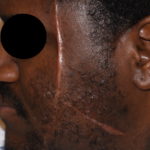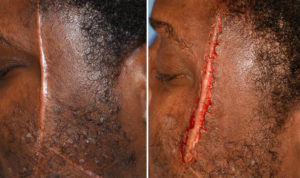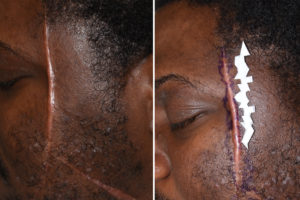Background: Scar revision is an inherent part of plastic surgery and is one of its most recognized and historic procedures. While scars occur all over the body, those on the face are the most frequently and successfully improved by various scar revision techniques. While there is a role for the more simpler linear excision and closure of facial scars, more frequently the concept of changing a more linear scar line into a non-linear one is used. This is seen as more effective at both an improved scar appearance and less recurrence of scar widening.
The reason for breaking up a facial scar into a non-linear pattern is based on two fundamental concepts. A linear scar line that runs askew from the relaxed skin tension lines on the face is better hidden when it has an irregular pattern, making the scar harder for the eye to follow. Secondly by having the edges of the scar line interdigitate in an irregular pattern throughout its length the forces of wound contraction are better dispersed through greater surface area contact than having a straight line. This results in a decreased chance of scar widening.
The most common techniques for changing an adverse linear facial scar are based on various geometries such as Z-plasties, running W-plasties and the geometric broken line scar revision. Each of these has a role to play in scar revision and they do not all apply to every facial scar. The geometric broken line scar revision technique is the most common that I use because it offers the greatest disruption of any scar line and this the greatest amount of camouflage.



Highlights:
1) Severe linear facial scars are best improved by a geometric broken line scar revision technique.
2) The geometry of the scar revision closure pattern is not as important as that there is one for both improved camouflage and less tension on the closure.
3) Geometric broken line closure improves a scar’s appearance but it can not make it completely invisible.
Dr. Barry Eppley
Indianapolis, Indiana



